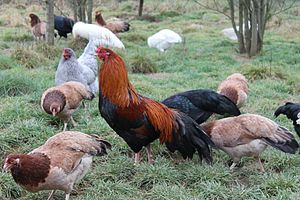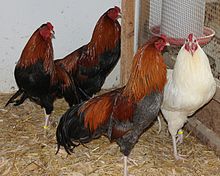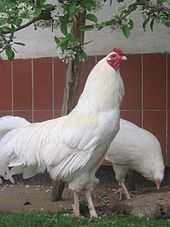Cubalaya
| Cubalaya | |||
|---|---|---|---|
|
|||
| Origin: | Cuba | ||
| Year: | 1983 | ||
| Colour: | wild-cinnamon-colored, blue-cinnamon-colored, white | ||
| Weight: | Rooster: 2–2.5 kg Hen: 1.5–2 kg |
||
| Laying output per year: | 120 eggs | ||
| Eggshell color: | White or yellowish | ||
| Egg weight: | 50 g | ||
| Breeding standards: | BDRG | ||
| List of breeds of chicken | |||
Cubalaya is one of Cuba originating domestic chicken breed that by 1983 BDRG was approved. Cubalaya are medium-sized, agile long-tailed chickens with a sloping posture, medium-high position and a combative, challenging nature. Typical of the breed are the "lobster tail" and a straight back line that extends from the neck to the tip of the tail.
history
Cubalaya are said to descend from Manilos de Regla , a Filipino breed of fighting chicken, and Malayos Pavos or Ga Cua , Vietnamese fighters, who were brought to Cuba by Spanish and Portuguese sailors, where there was great interest in Asian poultry breeds at the end of the 19th century. Chickens with full and lush tails were preferred to animals belonging to the Malay type , with a high standing, very long neck, tight plumage and tail. Through intersections with Asian and European Gamefowl blows and types one emerged after years blow with remarkably long, full and almost dragging tail. Animals of this type had a strongly curved beak, deep-set sparkling eyes and an aggressive nature. In 1935 the breed was recognized with modern standards by the National Poultry Breeding Association in Cuba in the colors white, black and wild-colored. The name "Cubalaya" was chosen with the intention of identifying their descent from the old Malayos Cola de Camaron ( German crab-tailed Malay ), while at the same time emphasizing the origin of the modern breed, which was bred out in the Republic of Cuba. Four years later, in 1939, it was presented at the 7th World Poultry Congress in Cleveland and included in the "Standard of Perfection" of the American Poultry Association (APA).
The first Cubalaya from New Jersey reached the Federal Republic in 1978 ; In 1983 the breed was approved in the color scheme “wild-cinnamon-colored” by the Association of German Poultry Breeders in Germany. The colors "blue-cinnamon" and "white" followed in 1999 and 2001. The black color is not yet recognized in Germany. In the USA, the colors “blue” (German blue ), “silver duckwing” (German silver neck / cinnamon color ), “golden” (German orange neck / cinnamon color ) and “blue golden” (German blue orange neck / cinnamon color) are used ) bred. In the “Standard of Perfection” of the American Poultry Breeding Association (APA), however, only the colors “wild-colored-cinnamon-colored” (English black breasted red ), “white” ( white ) and “black” ( black ) are recognized.
features
Cubalaya cocks weigh between 2 and 2.5 kg, hens 1.5 to 2.0 kg. They have a long, muscular, broad torso that is carried slopingly. The chest is broad and full and protruding. The belly is drawn in tightly and tightly. The plumage is hard and long, shiny and dense.
The head is short and broad and has slightly protruding bulges above the eyes. The face is smooth and bright red. Cubalaya wear a three-row pea comb , a low comb made of three pearled rows of which the middle one is slightly higher. The crest is low at the front, rising towards the back and does not protrude beyond the eyes. In the hens it is smaller and its end is usually less pointing upwards. The throat and ear lobes are small, smooth, and red. The eyes are medium-sized, lively, somewhat deep-set and red to red-brown in color. The light horn colored beak is short, strong, and curved.
Your neck is long and strong. The neck hangings , the elongated, pointed feathers on the neck of the chickens, reach down to the shoulders. The back is broad and long and forms an uninterrupted line from the base of the neck to the tip of the tail. The back line of the hens slopes more towards the tail than that of the rooster. The shoulders protrude.
The wings are short and protrude on the shoulders . They are carried slightly lowered, but do not cover the thighs. The saddle, the section of feathers between the back and the tail, is fully feathered. The tail is long and broad and is carried well spread below the horizontal. It is somewhat arched and thus forms the breed-typical "lobster tail", which is reminiscent of the eponymous lobster due to the roof-shaped arched arrangement of the spread control springs . The length from the base of the tail to the tip of the tail should be greater than from the beak to the base of the tail. Sickles and ancillary sickles , the cock's tail cover feathers , are long, full and dragged. Hens have their tails lowered a little more. Any formation of a tail angle or a folded tail section are undesirable for the breed.
The thighs are long and muscular. The legs are featherless and of medium length; in young animals smooth, in old animals coarsely scaled. Double and triple spores are possible. This type of spore grows very slowly and was previously preferred to prevent injuries in rank fights. Hens can also form spores. The toes are well apart, long and, like the legs, flesh-colored.
The eggs of the Cubalaya are white or yellowish. Eggs intended for hatching should not weigh less than fifty grams.
The wild-colored and cinnamon-colored hue
Roosters of the “wild-cinnamon-colored” color range have a brown-red head. Your neck hangings merge into a shining gold tone in the lower part. The saddle curtain corresponds to it. The back is brownish red. The wing covers are deep red, the wing bands are glossy green and black. The black hand wings have a brown border. The secondaries - indoor banner is black with some brown hem. The arm- wing outer flag is red-brown with black ends that form a red-brown triangle when the wings are folded. The front neck, chest, abdomen and thighs are black. The tail is black with a green sheen. The black lower plumage is interspersed with reddish brown.
The head of the “wild-colored-cinnamon-colored” hen is maroon-brown, the neck hangings dark red-brown. The back, wings, saddle and tail feathers are cinnamon colored; Front neck, chest, belly and thighs light cinnamon colored. The black hand wings have a brown border, the inside flag is black, the outside flag is reddish brown. The tail is black with a cinnamon-colored edge. The lower control feathers usually have a brownish, peppery edge. The lower plumage is light gray, light cinnamon on some parts of the body.
White in the sickles of the cock, in the tail of the hen and the wings is undesirable but allowed.
The blue-cinnamon hue
Roosters of the “blue-cinnamon” color have a golden-brown head. The neck and saddle hangings are golden brown, which merges into a shining gold tone in the lower part. A blue shaft line drawing is permitted. The back of the roosters is golden brown. The wing covers are rich gold-red, their wing bands are blue, the wings are blue with a golden outer edge. The arm-wing inner flag is blue, partly with a golden border, the arm-wing outer flag is golden-brown with dark ends, which when the wing is closed, like the "wild-colored cinnamon-colored" ones, forms a golden-brown triangle. The front neck, chest, abdomen and thighs are blue. The tail section is also blue and can have a slight brown border. The cock's lower plumage is blue-gray.
The hen's head and neck hangings are cinnamon brown. The back, wings, saddle and tail feathers are cinnamon colored; Front neck, chest, belly and thighs light cinnamon colored. The wings are blue with a cinnamon brown outer edge. The inside flag is blue, the outside flag is cinnamon brown. The tail is blue with a cinnamon-colored border. There is usually a brownish peppered edge on the lower control springs. The lower plumage is blue-gray to light cinnamon in color.
White in wings and tail is undesirable but allowed.
The white color
The plumage of the white Cubalaya is creamy white. In the ornamental plumage of the cocks, the neck and saddle hangings and the small wing covers, a yellowish shimmer is permitted. Other colored deposits in the plumage are undesirable.
literature
- Walter Schwarz and Armin Six: The large poultry standard in color Volume 1 Chickens - turkey guinea fowl , 7th, revised and supplemented edition, Oertel + Spörer, Reutlingen 2004, ISBN 3-88627-511-6
Web links
- Homepage of the SV of Cubalaya breeders with standard on cubalaya.de.tl, information on the history of the breed and photo gallery
- Cubalayas on feathersite.com, English-language brief information, with a photo gallery of various colors (including APA)
- Cubalaya on mypetchicken.com, English-language brief information with a picture of a "Silver Duckwing" Cubalaya rooster
Individual evidence
- ↑ a b Entente Européenne d'Aviculture et de Cuniculture : Purebred poultry standard for Europe (Cubalaya). SV of the Cubalaya breeders, accessed April 3, 2013 .
- ↑ Michael Kruppert: History. In: cubalaya.de.tl. Julius Kölsch (SV of the Cubalaya breeders), accessed on April 3, 2013 .






